Overview
Lorenzo il Magnifico takes place during the time of the Renaissance in Florence, Italy. Each player is the leader of a noble house and throughout the game they will be sending their family members out into the different boroughs of the city on various missions in an effort to achieve fame and glory, while also maintaining a strong relationship with the church.
Each player controls three family members in different colors – white, black, and orange – as well as one neutral family member. With the exception of the neutral family member, each of these units has a numeric value associated with it that is determined at the beginning of each round by rolling some dice, although the values can be altered in various ways. In between the players is a central game board and players will take turns sending their family members to different areas of the board, following specific placement rules, to perform the associated actions. These actions will help the players earn the resources needed for them to earn the victory points (VP) they will need to win the game. When the game comes to an end, the player who has scored the most will be declared the victor.
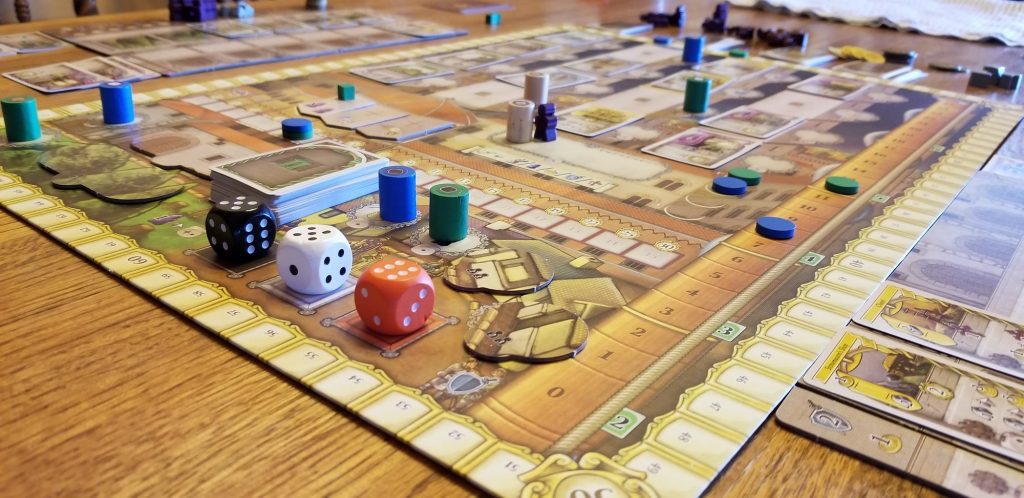
If you’re just interested in finding out what I think about this game, then fast forward to the Thoughts section. If you’d like to delve deeper into how the game is actually played, then read on.
Setup
First, the game board is laid out and the various cards are separated by color and then by the Roman numerals on the card backs. Each collection of Roman numerals within each color is shuffled into a mini-deck, and then these are stacked together into different decks so that the IV cards in each color are on the bottom of the deck with the III cards on top of those and so forth. These decks are placed above the game board above the matching towers – blue cards above the blue tower, for instance. Then cards are drawn from the tops of each deck and placed into the four tower locations of each different tower. Next, three Excommunication tiles are drawn at random (one for each era) and placed face up into the appropriate location on the board. If playing with fewer than four players, different sections of the board are covered up with the cover tiles accordingly.
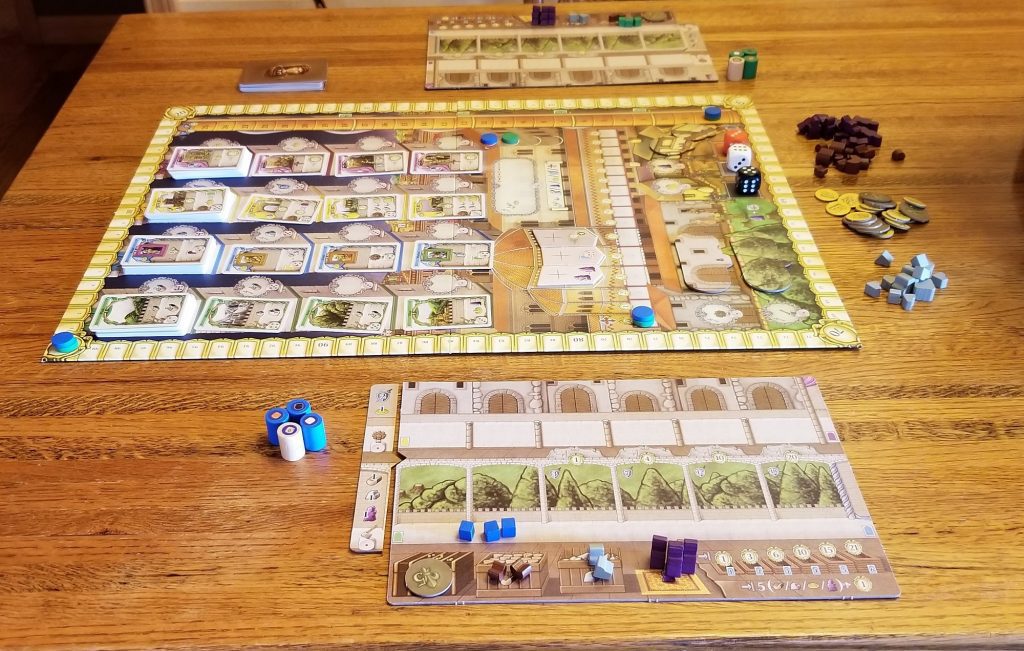
Next, each player chooses a color and takes the player board, Excommunication cubes, Family Members, and marker discs of the chosen color. One marker disc is placed onto the zero of the score track. The others are placed at the beginning of the Military Points track, the Turn Order track, and Faith Points track. Each player also receives a Personal Bonus tile which is placed next to their player board as well as 2 small wood, 2 small stone, and 3 servants. Then a start player is selected. Players begin with some coin based on their turn order. Finally, the three dice and all of the other resources are placed close by and you’re ready to begin playing Lorenzo il Magnifico.
Taking Action
At the beginning of each round (of which there are six total) the three dice are rolled and placed into their locations on the game board. The faces on these dice dictate the values that each matching color Family Member will be for that turn. In the example below, the black Family Member has a value of 5, the white a value of 5, and the orange a value of 6. The neutral Family Member does not have any intrinsic value.

When a family member is sent out to a location on the board, they will perform the associated action with a starting value of whatever their number is. This starting value may be boosted by accompanying the Family Member with any number of servants. For instance, if you were to send out the black Family Member above along with 2 servants, its value would be 7 instead of just 5.
The Different Locations
The game board is divided into several action locations. At the bottom left of the board are the harvest and production locations. These will be explained in more detail in the next section. To the right of these are some generic actions that will give the player using them extra gold, extra servants, extra Military Points and gold, or the ability to take any two Council Privileges of their choice. Directly above these is the Council Privileges action which will provide any player taking the action a number of resources or movement along the various tracks. This section is also how turn order is determined at the end of a round.
Each action located on the board has a pip value printed on it which dictates the minimum numeric value a Family member must have in order to take the action. And, with the exception of the Council Privileges space and the harvest and production spaces at higher player counts, once an action location has been taken, in true worker placement form, that action will become unavailable for anyone else to choose for the remainder of that round.
The most prominent feature on the game board is the four different towers. In order to send Family Members to the towers, there are some specific placement rules that must be followed. No player is allowed to send any of their colored Family Members to any tower where one of their other colored Family Members has already been sent. The neutral Family Member can be sent to any tower, however. Also, if any Family Member from any player has already been sent to the selected tower, then the player must pay 3 gold to the bank in order to send one of their Family Members there.
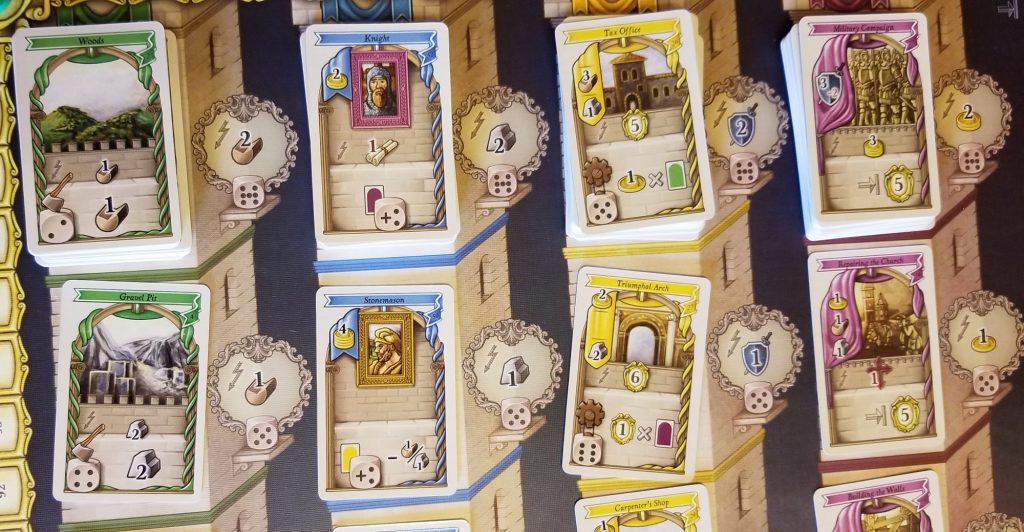
Each of the tower locations houses a card. To obtain the card, the associated cost must be paid and then the card is placed onto the player’s player board in the appropriate location. Some cards/locations will provide immediate benefits as soon as they are obtained/selected. Most cards will provide some kind of lasting benefit. The purple cards provide immediate bonuses as well as end of game VP. The blue cards typically provide some kind of immediate benefit as well as some ongoing benefit such as adding pip values to specific actions whenever they are performed. The yellow and green cards usually provide an immediate benefit and will also provide various resources, track movements, or VP once they are added to your engine and the engine is run.
Running the Engine
As cards are added to your player board so, too, does the breadth and scope of your engine expand. On the main game board are the harvest and production actions. The output of your engine depends entirely upon the value of the Family Member that is placed on these action locations. In the following example, there are two engines – the production engine at the top and the harvest engine at the bottom. At the beginning of the game, the players each received a Personal Bonus tile which was placed to the left of the player board. Let’s take a look at the harvest engine.
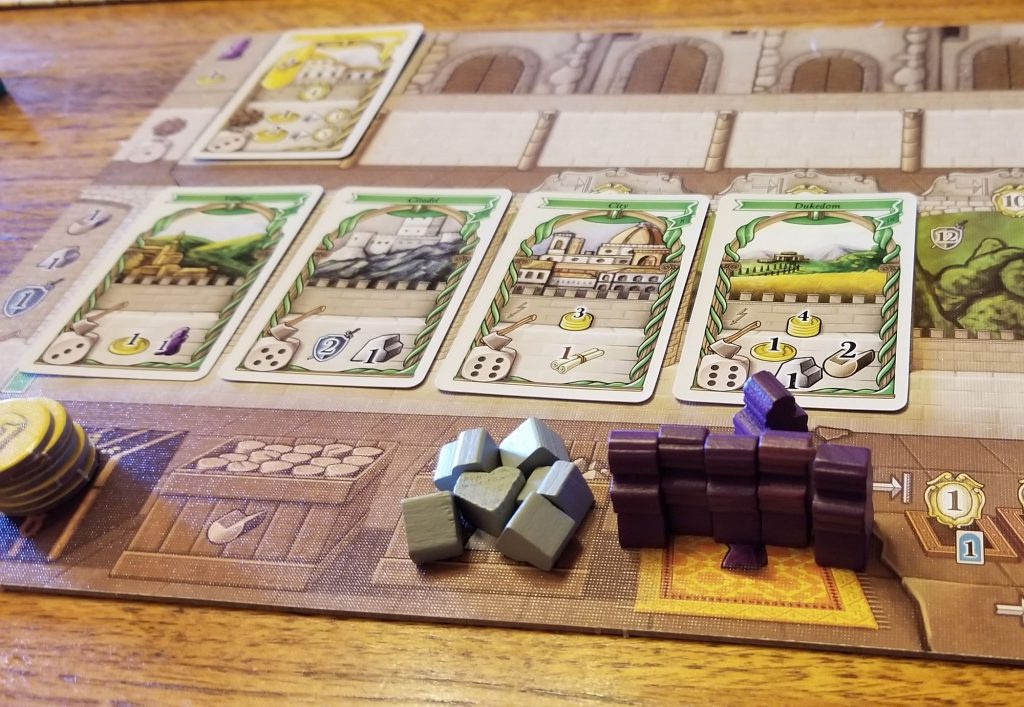
If the player were to place a Family Member on the harvest location with a value of 3, they would only receive the benefits from their Personal Bonus tile and the card on the far left with the 3 pip value on it: 1 wood, 1 stone, 1 Military Point, 1 coin, and 1 servant. However, if they have taken the action with a value of 6, they would be able to reap the rewards from their Personal Bonus tile as well as all four of the different cards: the rewards already mentioned as well as 1 Council Privilege of their choice and an additional 1 coin, 1 stone, and 2 wood. Running the production engine in this example wouldn’t be nearly as impressive as this player has only managed to collect a single yellow card, but it would work exactly the same – the higher the Family Member value used to perform the action, the more they’ll get out of the engine.
Supporting the Church
At the end of Rounds 2, 4, and 6 the players must choose whether or not to support the Church. Choosing not to do so will result in them being excommunicated which will result in a negative penalty for the remainder of the game. At the end of round 2, the player must have accumulated at least 3 Faith Points. At the end of round 4: at least 4, and at least 5 at the end of round 5. If the player has not accumulated enough, they are automatically excommunicated and their marker remains wherever it is on the Faith Points track. They then place one of the Excommunication cubes onto the appropriate Excommunication tile. This marks the negative penalty they will suffer.

In the above example, the first negative penalty is: whenever the player would collect a servant from any action, they will collect one servant less. If, however, the player DOES have enough Faith Points and chooses to support the church, they earn VP equal to the number above their current location and then their marker is moved back to the 0 spot.
End Game and Scoring
The game comes to an end after the completion of the sixth round. At that time, the final scores are tallied and the player with the most VP wins. VP comes from several different things:
- Collected purple cards
- VP based on how many blue cards were collected
- VP for highest and second highest Military strength
- VP for conquered territories (cards placed into the locations higher up on the harvest spaces)
- 1 VP for every 5 leftover resources regardless of what they are
And players will receive negative VP if they were unable to support the church at the end of the sixth round.
Advanced Game
There are some advanced variants which I did not discuss here in which one or two or even both of the following are true:
- Each player flipped their Personal Bonus tiles to their opposite side which revealed different bonuses for the harvest and production actions.
- Each player received Leader cards at the beginning of the game (determined by a card draft) which gave them specific objectives and rewards once those objectives were completed.
While I do not discuss these here, I still thought you might want to be made aware that they exist.
Thoughts
The first time that I encountered Lorenzo il Magnifico was at a paid event at Gen Con 50 in 2017. I got my butt handed to me. It was my and my wife’s first Gen Con ever. Being super excited, we’d been running hard on very little sleep and I was having trouble wrapping my brain around everything that was going on within the game (while not terribly complex, some of the intricacies of how the various mechanics work together don’t become obvious until after several plays). My wife, however, caught on immediately and she gave the other guy that we were playing with a run for his money and managed to squeak out a win. I wasn’t immediately sold on the game, but I was sold on the fact that she was sold on it. I mean, I thought that it seemed like a solid game, but I didn’t really feel like I’d had enough experience with it to make an informed decision on whether or not to purchase it. Ultimately, though, after some time passed, we wound up buying it and man am I ever glad that we did. Lorenzo il Magnifico rocks!
The thing that I immediately noticed that first time that we played was the always impeccable artwork by Klemens Franz. Something about his illustrations just speaks to me in every single game that I have played that he’s had a hand in. It’s one of the reasons that I selected him as one of the Top 6 Board Game Illustrators. I find his work in Lorenzo il Magnifico to be both edifying and exhilarating – particularly the box cover. WOW! That box cover is just gorgeous.
The component quality is nothing to balk at either. The card stock has a nice snap to it. The cardboard is thick and durable. Even the rule book is stellar. The only thing to dislike about the wooden components are that the large wooden pieces that represent five of the smaller wooden pieces aren’t really large enough to tell the difference at a glance. That decision was a strange one and I think that I would have preferred all of the wooden bits to remain the same size and just use multiplier tokens instead. That being said, the wooden bits are still very nicely crafted.
And, if you look beneath the attractive veneer, you’ll discover a finely crafted game.
The design team of Flaminia Brasini, Virginio Gigli, and Simone Luciani have worked together before in different groupings on such well known titles as Grand Austria Hotel and Leonardo Da Vinci (and more recently, Coimbra and Newton). So going into it for the first time, I knew that there was some real design pedigree behind this game and my expectations were high. I was not disappointed. Lorenzo il Magnifico hums along like a well oiled machine. Each part feels necessary and there is zero fluff.
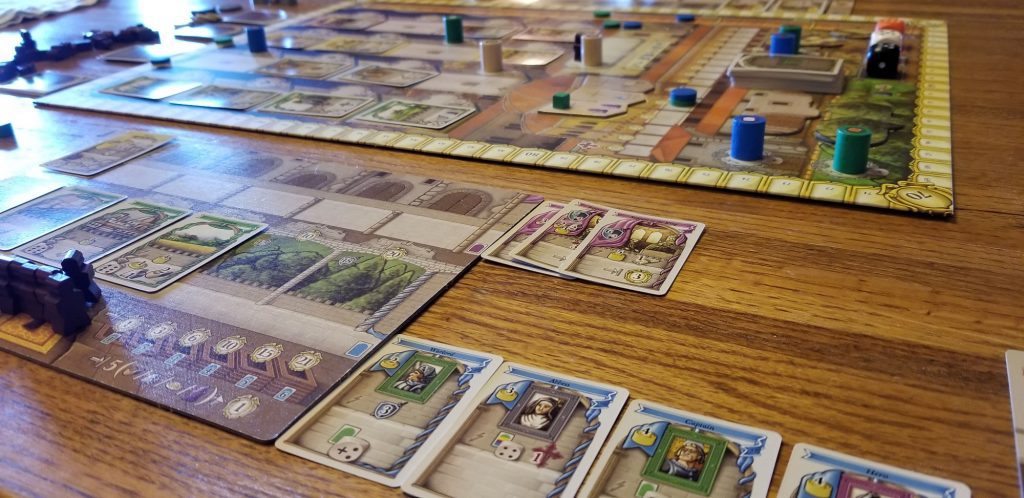
One of my favorite things in board games is when I am able to build an engine and then sit back and watch it do its thing. There’s nothing more satisfying than starting a turn with virtually nothing and ending it with a pile of resources to work with. Lorenzo il Magnifico has that in spades… provided your opponents don’t beat you to it. And there’s the rub. There are times when the dice values aren’t as good as you might wish they were. Maybe you just need one or two additional servants to run your engine in such a way as to reap the rewards of all of your cards. Do you try to grab those servants first or is your best bet to run your engine now while you have the chance even though doing so might be woefully inefficient? There’s no reward without a little risk.
I’m also a big fan of “point salad” games… games where your VP come from many different sources. In a lot of games it can be pretty easy to tell who’s going to win pretty early on and that can feel rather disheartening. With games like Lorenzo il Magnifico, though, it often comes down to the wire. One person may be way ahead of everyone else and they might appear to be a shoe-in, but then someone turns on their point engine and goes blasting past them at the last second. It’s pretty awe inspiring both as the person scoring big and the person being passed. More importantly, it means that everyone is constantly engaged and on high alert.
Engine building, worker placement, resource management, point salad… Lorenzo il Magnifico’s got all of the elements that I love so much about eurogames and they’re all wrapped up into one nice and tidy package. I absolutely adore this game and I’m hard pressed to find anything negative that can be said about it. Aside from the issue with the wooden bits described above, my only other complaint would be that there was only one single Leader card reference provided. When you’re playing the Advanced variant and have no idea what the cards in your hand do, it’s very frustrating to have to wait for everyone else to take turns looking at the sheet first to figure out what THEIR cards do. And then you get to do it all over again when the un-drafted cards from your opponents come to you. I wish they’d included more than one of these.
Aside from that, though, Lorenzo il Magnifico is a marvelous game and it’s one that I’m always excited to get to the table.












Add Comment